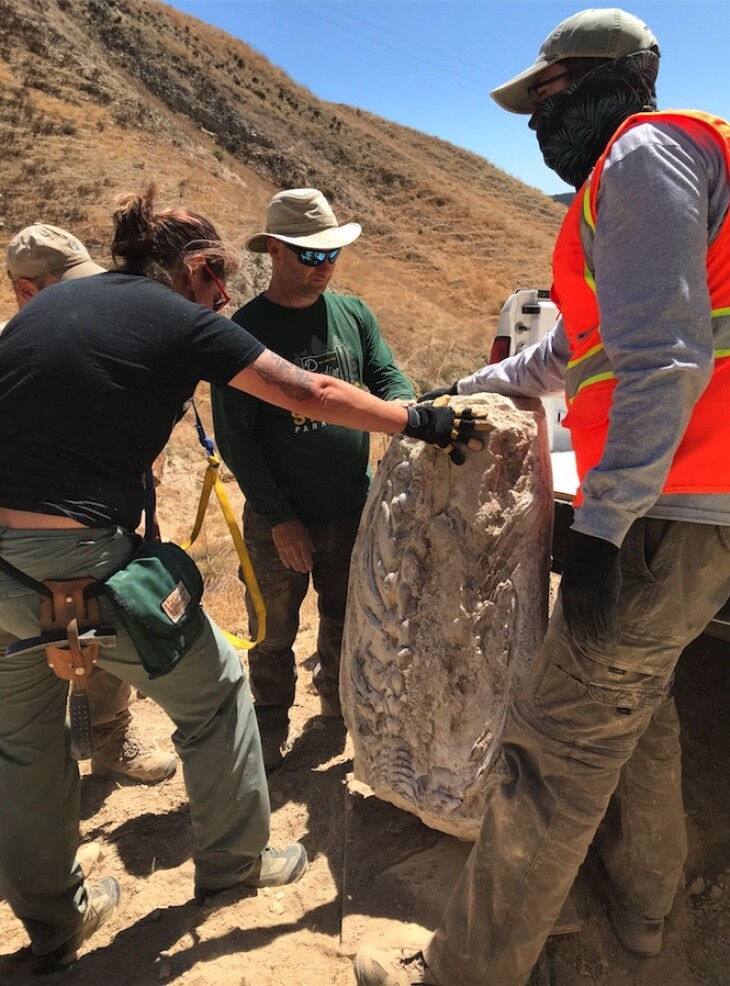Truth matters. Community matters. Your support makes both possible. LAist is one of the few places where news remains independent and free from political and corporate influence. Stand up for truth and for LAist. Make your year-end tax-deductible gift now.
Earthquakes Shook Loose A 15-Million-Year-Old Sea Creature In Simi Valley

Like any good mystery, this story begins with a body -- in this case, the remains of a sea creature that once swam in the ocean that covered Simi Valley millions of years ago.
The "body" was discovered by a crew checking on utilities following the earthquakes that rattled Southern California last July. The quakes had evidently shaken loose a big pale fossil, which had tumbled onto a private road. Since fossils are protected by law, the crew called in the experts, and arrangements were made for scientists at Cal State University Chico's Geological and Environmental Sciences department to retrieve it.
Russell Shapiro, professor of paleontology, and department chair Todd Greene, a specialist in deep marine sediments, led a team of volunteers from environmental consulting firm SWCA to the site a few miles north of the 118 Freeway in Tapo Canyon.
What they discovered, as Shapiro described it, was a "large, beautiful torso." But identifying the creature to which it belonged has proven tricky.

The fossil itself is incomplete, as massive as it is. It took six people to lift the 4-foot-long block, which weighs about 600 pounds, Shapiro said. Along its length, vertebrae and ribs protrude slightly from its white surface. Found nearby were many other fossils that they collected for further study, mostly from a large whale. But Shapiro was hesitant to lump them together.
In general, fossilized vertebrae and ribs of mammals are kind of useless in determining what type of creature it is, Shapiro said. What's really important is the neck. But while the cervical vertebrae were stacked like a whale's, "the ribs, however, do not look like a normal whale's ribs, and that's what's confusing me."
If the team had found a head, teeth or extremities, like flippers or a tail, "that would be very much diagnostic," Shapiro said.
One clue to its identity -- and age -- lies in the area's geology. The creature's final resting place is a layer of very fine sediment that was once the deep-sea bottom. Known as the Monterey formation, parts of which are visible in areas like Beverly Glen and the Palos Verdes Hills as layers of light-colored rock, it dates back to the Miocene era, a time when kelp forests emerged.
In addition to being a treasure trove of whale, dolphin and crab fossils, the Monterey formation has yielded much of the state's extracted oil. Its deposits of long-dead algae also produce diatomaceous earth used for swimming pools and other water filtration. Based on the formation's place on the geologic timeline, Shapiro's team estimates the animal is around 15 million years old. He said they hope to find a "diagnostic fossil" among the others collected at the site to narrow down the age range.

Shapiro may not know for sure what they found, but he does have a hunch. The paleontologist is leaning toward a small whale, either a youngster or an adult from a smaller whale species.
But it could also be a type of plant-eating mammal that belonged to the extinct family Desmostylidae, which once roamed the Pacific Ocean -- although typically in shallower waters. Shapiro likened it to a "sea hippo" and noted that he's found fossilized remains in younger rock in Ojai. Also, back in 1996, a jawbone was found near the 241 toll road in Mission Viejo.
The Simi Valley fossil is ultimately destined for public display, though Southern Californians will have to travel to see it. The chunk will go to Gateway Science Museum, a kid-friendly display space on the Chico State campus that is allowed to collect objects that are protected by federal law.
As a bonus, visitors will likely be allowed to touch it.
"The nice thing about this one is that it's so rock-hard, it's easy to protect it and allow the public to touch it without damaging it, so we're hoping to have schoolkids and others come by to see it and understand the rich history of California," Shapiro said.
The paleontologist said he hopes the exhibit will attract another type of visitor, too: marine mammal experts who might be able, finally, to help solve the mystery of this sea creature's identity.
Brianna Flores contributed to this story.







